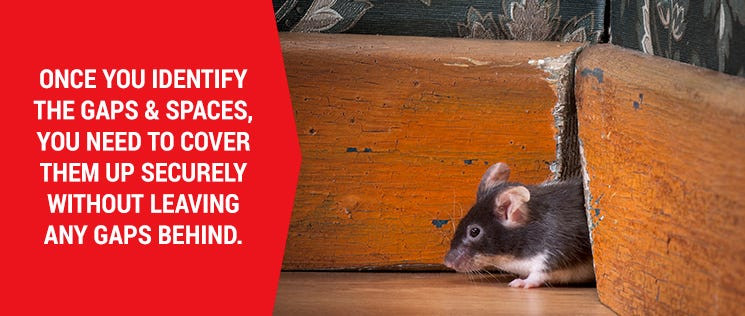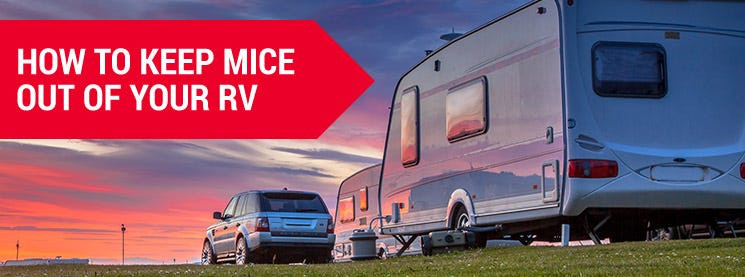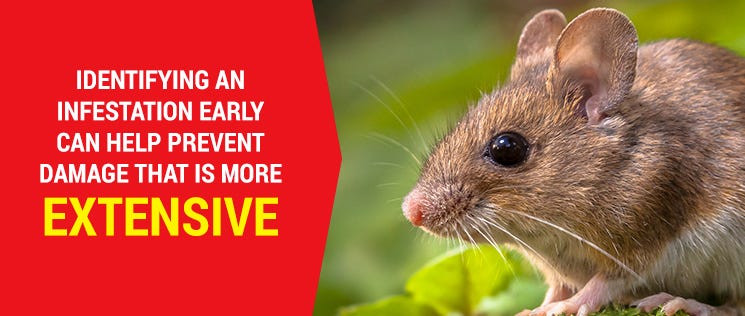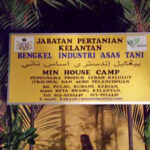Keeping mice out of your travel trailer is essential for a pleasant and healthy travel experience, and SIXT.VN is here to help. By identifying entry points, implementing preventive measures, and taking swift action against infestations, you can ensure your RV remains a comfortable and pest-free home on wheels. Let’s explore proven strategies to safeguard your travel trailer from these unwanted guests, ensuring you enjoy every adventure worry-free with our travel tips, affordable travel accommodations, and convenient travel services.
1. Understanding How Mice Invade Your Travel Trailer
Don’t underestimate a mouse’s ability to squeeze through incredibly small spaces to invade your RV.
It only takes a tiny opening for mice and other rodents to gain access to your RV. A mouse can fit through a hole about the size of a dime, while rats only need a hole the size of a nickel. Even a tiny opening where pipes enter the RV or a skinny gap on the underside of the unit is enough for a mouse to shimmy through to get into your camper. Once inside, the mouse is not likely to leave willingly. According to research from the National Pest Management Association in 2023, rodents can squeeze through openings much smaller than their body size due to their flexible bodies.
Common entry points for rodents in an RV include:
- Cracks around doors
- Poorly sealed pull-out sections
- Gaps around plumbing or wiring
- Gaps in the floor
- Corners or cracks where walls meet
- Access panels for plumbing, electrical, etc.
Mouse and rodent infestations often occur while your RV is in storage for the winter. According to a study by the University of California, Davis in 2022, RVs stored for extended periods without proper protection are prime targets for rodent infestations. For several months of the year, the camper is empty without much activity, making it the perfect spot for rodents to hang out unnoticed. An RV is a warm, cozy place for a mouse to take up residence during the winter months. If you live in a cold climate, rodents have an even bigger incentive to find a warm home and food to survive the winter. Any food left inside an RV is like an all-you-can-eat buffet for the rodent.
2. What Are The Dangers of Having Mice in Your RV?
Mice and rodents are more than a minor annoyance; they can cause significant damage to your RV.
Rodents will chew through almost anything, including upholstery, cushions, wiring, and the plastic and rubber lines that serve crucial functions in your RV. They make nests inside the RV, often using the chewed-up components to build those nests. Not only is it expensive to repair, but all of that damage is a big mess to clean up. The Environmental Protection Agency (EPA) reports that rodent damage to vehicles and structures costs billions of dollars annually.
Rodents can also spread disease, making cleanup potentially dangerous to your health. According to the Centers for Disease Control and Prevention (CDC), rodents are known to spread over 35 diseases. The last thing you want to worry about when you finally get out in your RV is getting sick. They can also carry parasites, which then get into your RV. By keeping mice out of your RV, you can enjoy your time out in nature without worrying about diseases spread by rodents.
3. How Can I Identify Entry Points for Mice and Rodents?
Keeping rodents away from the start is the most effective way to protect your RV.
By stopping mice and other rodents from ever entering your camper, you eliminate the mess they make and save yourself money on pricey repairs. According to the National Pest Management Association (NPMA), proactive prevention is the best defense against rodent infestations.
RVs typically offer up plenty of little entry points that allow mice to get inside. Finding those points is the first step in keeping mice out. Here are tips for finding those entry points so you can block them to keep mice out:
- Crawl under your RV to spot gaps and holes. Even small gaps are often large enough for mice to fit in.
- Head inside on a sunny day to look for daylight streaming through different parts of the RV. If you can see daylight, mice can find a way in. Another option is to look at night with one person outside shining a light at various areas around the camper and another person inside to look for signs of the light shining through.
- Open drawers, cabinets, and closets to look for signs of sunlight.
- Look in corners and along edges for gaps.
- Focus on areas where plumbing and wiring come into the RV’s living area. Any gaps around them are space enough for mice to squeeze through.
- Check the seals on any slide-out areas on the RV. If the seal is not secure, mice and rodents could get in through this area.
- If your RV bathroom or other areas have access panels, remove them to look inside for potential entry points.
 Identify the gaps and cover them securely
Identify the gaps and cover them securely
Once you identify the gaps and spaces, you need to seal them. Expanding spray foam is an easy solution. The product expands as it dries, quickly filling the entire space. Experiment with the foam if you have never used it before to ensure you don’t use too much. Be aware the expanding foam could cause damage to the RV if you overdo it.
Silicone caulk is another effective way to seal up small cracks or gaps. Thin pieces of wood or sheets of metal can also work to cover some gaps and holes, depending on the location.
4. What Are The Winter Storage Tips for Campers to Keep Mice Away?
Winter is often the prime time for mice to invade an RV, so adjusting your storage routine can prevent infestations.
Mice can find their way into an RV no matter where it is parked, but there is an increased chance if you store the camper outdoors near fields or open areas. If possible, park the RV on a hard surface away from grassy or wooded areas. A study by the University of Nebraska-Lincoln in 2021 found that rodents are more likely to infest vehicles stored in or near natural habitats.
Before you store your RV for the winter, clean out any food sources that could attract rodents. That includes dried food items, condiments, and other items that would otherwise be fine all winter long in the camper. They serve as a source of food for all those mice seeking refuge in the winter. Even if you store the food in plastic bins, the rodents will find a way to chew through the containers to reach the food. The containers may slow the mice down a little, but they will not stop them completely. The USDA recommends removing all potential food sources to prevent rodent attraction.
Clean out your camper well to remove any food remnants or crumbs. Any remaining crumbs or debris may attract rodents to your RV.
Check on your RV regularly while it is in storage, if possible. If you store your RV at a storage facility, you won’t likely have a chance to check it very often. If you store it at home, walk through the RV when possible to look for signs of a rodent infestation. Starting up the engine on a motorhome-style RV can help scare away rodents who try to make a home in the engine compartment.
 Mice out of RV
Mice out of RV
5. How to Repel Mice and Other Rodents From RVs?
Even with thorough cleaning and sealing, mice may still try to seek refuge in your RV.
That does not mean you just have to accept the invasion and subsequent damage. Repelling products can be a last line of defense in keeping your RV rodent- and damage-free. According to research from Kansas State University in 2022, using repellents in conjunction with other preventative measures can significantly reduce rodent infestations.
Peppermint oil is a simple product that can protect your RV, because rodents do not like the scent. They find it unpleasant, which causes them to avoid it. The bonus for using peppermint oil is it’s generally considered a pleasant scent to most people. It is safe and natural, so you do not have to worry about your pets or kids getting into it.
Peppermint oil can be quite messy, particularly in hard-to-reach areas of your RV, such as tight corners or tiny cupboards. An easy solution is to use Victor® Scent-Away™ Natural Rodent Repeller Packs™. The peppermint oil is infused in small granules, which are kept inside permeable mesh pouches. Simply place the pouches in cupboards, drawers, and other areas in your camper for up to 30 days of mouse-repelling scent. When you’re making your regular check on your camper, take time to replace the pouches each month to make sure they are effective.
6. What Are The Most Effective Natural Rodent Repellents?
Natural rodent repellents offer a safe and eco-friendly way to deter mice and rats from your RV.
These options often use scents and ingredients that rodents find unpleasant, making them an effective addition to your pest control strategy. According to a study published in the “Journal of Economic Entomology” in 2020, certain essential oils can be as effective as chemical repellents in deterring rodents.
- Peppermint Oil: As mentioned, rodents dislike the strong scent of peppermint. Soak cotton balls in peppermint oil and place them in entry-prone areas, such as corners, cabinets, and near plumbing.
- Essential Oil Blend: Combine peppermint, eucalyptus, and citronella oils for a potent repellent blend. Mix a few drops of each oil with water in a spray bottle and apply to areas where rodents might enter.
- Bay Leaves: Place bay leaves in cupboards, drawers, and other storage areas. Rodents are repelled by the scent and taste of bay leaves.
- Cloves: Scatter whole cloves around the RV, particularly in areas where you suspect rodent activity.
- Cedarwood: Use cedarwood shavings or blocks in storage compartments. Cedarwood is a natural insect and rodent repellent.
- Vinegar: Spray white vinegar around the perimeter of your RV and in entry points. The strong smell deters rodents.
- Ammonia: Place a bowl of ammonia in the RV during storage (ensure proper ventilation). The strong odor is unpleasant for rodents.
- Chili Powder or Cayenne Pepper: Sprinkle chili powder or cayenne pepper near entry points. The spicy scent can deter rodents.
- Onions and Garlic: Place slices of onion or garlic near potential entry points. The strong smell repels rodents.
- Castor Oil: Soak cotton balls in castor oil and place them around the RV. Rodents dislike the smell and taste of castor oil.
Using these natural repellents can create a less inviting environment for rodents, helping to keep your RV pest-free. For reliable and convenient travel services in Vietnam, including travel tips and affordable accommodations, visit SIXT.VN.
7. How Can I Tell if I Have a Mouse Infestation in My RV?
Identifying a mouse infestation early can prevent more extensive damage.
Here are some signs that indicate a mouse or rodent problem: The University of California, Agriculture and Natural Resources, emphasizes the importance of early detection to minimize damage and health risks associated with rodent infestations.
 Mouse Infestation
Mouse Infestation
- Mouse Droppings: Where there are mice, there are sure to be droppings. Look along the walls, in drawers, and in cabinets for mouse droppings if you don’t see obvious piles when you enter.
- Holes: When mice get into your RV, they are likely going to chew through things. Be sure to inspect the mattresses and bedding in the RV to see if you spot holes or chew marks from rodents.
- Chewed Food: If you leave food in your RV, inspect the packaging. Mice are likely to chew through the packages to reach the food inside.
- Natural Food: Rodents may bring natural food sources inside the RV. If you notice anything out of the ordinary inside your RV, you could have a rodent problem.
- Nests: Once rodents decide to take up residence in your RV, they will likely make nests to stay cozy. Look for nests in the RV, particularly around bedding and mattresses.
8. What Steps Should I Take If My RV Has a Rodent Infestation?
If mice get in despite your best efforts or before you have a chance to seal up the RV, take care of the situation immediately.
Waiting gives the rodents more time to cause damage in your RV. Use traps to remove the active infestation. Victor® Kill Vault™ mouse traps offer a hygienic solution to get rid of the mice quickly without a mess. The trap humanely kills the mouse and seals it inside the trap, along with parasites, urine, feces, and blood to reduce your exposure. You don’t have to mess with seeing or picking up the dead rodent yourself since it is sealed inside the trap. According to the EPA, using traps is one of the most effective methods for controlling rodent populations.
You also need to do a little more investigation into where the mice are entering the RV. If you already looked for gaps and thought you got them all, do another thorough inspection to find potential entry points you missed. Setting up traps throughout the RV can help narrow down the locations of the gaps. If most mice end up in traps in a particular part of the camper, such as the bathroom, focus on that area when looking for the entry points.
After about a week of no new mice in your traps, you can reasonably assume the infestation is over and you found and sealed the entry points. Waiting a week also ensures any viruses in rodent urine and droppings inside the camper are no longer infectious, so you can safely clean up the camper.
9. How Do I Clean An RV After a Rodent Infestation?
Cleaning an RV after a rodent infestation requires thoroughness to eliminate health hazards and prevent future infestations.
Follow these steps to ensure a safe and clean environment. The CDC recommends taking specific precautions to minimize exposure to rodent-borne diseases during cleanup.
- Ventilate the RV:
- Open windows and doors for at least 30 minutes before starting the cleanup process to air out the RV.
- Wear Protective Gear:
- Put on rubber or latex gloves to protect your skin from potential pathogens.
- Wear a mask to avoid inhaling dust and allergens.
- Disinfect Droppings and Urine:
- Spray rodent droppings and urine with a disinfectant or a solution of one part bleach to 10 parts water.
- Let the solution sit for at least 5 minutes to kill any bacteria or viruses.
- Remove Droppings and Nests:
- Use a paper towel to pick up the droppings and nesting materials.
- Dispose of the paper towel and materials in a sealed plastic bag.
- Clean and Disinfect Surfaces:
- Wipe down all hard surfaces, including countertops, floors, drawers, and cupboards, with a disinfectant.
- Pay special attention to areas with evidence of rodent activity.
- Steam Clean Upholstered and Carpeted Surfaces:
- Steam clean upholstery and carpets to remove any lingering contaminants.
- If you don’t have a steam cleaner, use a vacuum with a HEPA filter.
- Wash Fabrics:
- Wash bedding, curtains, and other removable fabrics in hot water.
- Add bleach to the wash if possible to kill any remaining bacteria.
- Inspect and Repair Damage:
- Check for any damage caused by rodents, such as chewed wires or holes in walls.
- Repair any damage to prevent future infestations.
- Seal Entry Points:
- Identify and seal any entry points that rodents may have used to get into the RV.
- Use caulk, steel wool, or expanding foam to seal gaps and cracks.
- Final Ventilation and Cleaning:
- After cleaning, ventilate the RV for several hours to ensure all odors and fumes are gone.
- Wash your hands thoroughly with soap and water after removing your gloves and mask.
Following these steps can help you safely and effectively clean your RV after a rodent infestation, creating a healthier and more enjoyable travel environment. For convenient and reliable travel services in Vietnam, including travel tips and affordable accommodations, visit SIXT.VN.
10. What Are The Most Common Mistakes To Avoid When Trying To Keep Mice Out?
Preventing mice infestations in your RV requires vigilance and a comprehensive approach. Avoiding common mistakes can significantly improve your success. Here are key errors to avoid:
- Neglecting to Seal Entry Points:
- Mistake: Failing to seal even small gaps and cracks in the RV’s exterior.
- Solution: Regularly inspect the RV for potential entry points, including around pipes, wiring, and doors. Use caulk, steel wool, or expanding foam to seal these gaps effectively.
- Leaving Food Inside the RV:
- Mistake: Storing food, even in sealed containers, inside the RV during storage periods.
- Solution: Remove all food items, including dry goods, snacks, and pet food, before storing the RV. Clean up any crumbs or spills to eliminate food sources for rodents.
- Ignoring Interior Cleanliness:
- Mistake: Neglecting to clean the interior of the RV regularly, allowing crumbs and debris to accumulate.
- Solution: Thoroughly clean the RV after each trip, paying attention to areas where food is prepared and consumed. Vacuum carpets and wipe down surfaces to remove potential food sources.
- Skipping Regular Inspections:
- Mistake: Failing to check the RV regularly for signs of rodent activity during storage.
- Solution: Inspect the RV at least monthly for droppings, nests, or chewed materials. Early detection can prevent a full-blown infestation.
- Using Ineffective Repellents:
- Mistake: Relying on repellents that are not potent enough or using them improperly.
- Solution: Use a combination of natural repellents like peppermint oil and commercial rodent repellents. Place them in strategic locations and replace them regularly.
- Overlooking Exterior Surroundings:
- Mistake: Parking the RV near potential rodent habitats, such as grassy fields or wooded areas.
- Solution: Park the RV on a hard surface away from vegetation. Keep the surrounding area clear of debris and potential nesting materials.
- Ignoring Proper Waste Disposal:
- Mistake: Leaving trash or food waste near the RV, attracting rodents to the area.
- Solution: Dispose of trash in sealed containers and keep them away from the RV. Regularly empty trash cans to prevent odors and potential food sources.
- Neglecting Maintenance:
- Mistake: Failing to maintain the RV’s structure, allowing small issues to become larger entry points.
- Solution: Regularly check and repair any damage to the RV’s exterior, including tears in screens, loose seals, and cracks in the siding.
- Assuming One-Time Treatment Is Enough:
- Mistake: Believing that sealing entry points and cleaning once will solve the problem permanently.
- Solution: Implement ongoing preventive measures and regularly reassess the RV’s vulnerability to rodent infestations.
- Not Seeking Professional Help:
- Mistake: Hesitating to call a professional pest control service when dealing with a severe or persistent infestation.
- Solution: Contact a qualified pest control expert for assistance with trapping, removal, and prevention strategies.
By avoiding these common mistakes, you can significantly reduce the risk of rodent infestations and keep your RV pest-free. For comprehensive travel services in Vietnam, including affordable travel accommodations and expert travel tips, visit SIXT.VN.
FAQ: Keeping Mice Out of Your Travel Trailer
-
How do mice get into my RV?
Mice can squeeze through incredibly small openings, about the size of a dime, to enter your RV through cracks around doors, gaps in plumbing, and other unsealed areas.
-
What damage can mice cause in my RV?
Mice can chew through upholstery, wiring, and plastic components, causing costly damage. They also build nests, spread diseases, and introduce parasites.
-
How can I find entry points in my RV?
Check for gaps under the RV, look for daylight streaming through cracks, inspect corners, and focus on areas where plumbing and wiring enter the RV.
-
What are some winter storage tips to keep mice away?
Park your RV on a hard surface away from grassy areas, remove all food sources, clean the RV thoroughly, and check on it regularly.
-
How effective is peppermint oil as a mouse repellent?
Peppermint oil is a natural repellent that mice dislike. You can use cotton balls soaked in peppermint oil or commercial repellent packs.
-
What are the signs of a mouse infestation in my RV?
Signs include mouse droppings, holes in bedding, chewed food packaging, and nests in hidden areas.
-
What should I do if I find a mouse infestation in my RV?
Use traps to remove the mice, identify and seal entry points, and thoroughly clean the RV with disinfectant.
-
How do I clean my RV after a mouse infestation?
Ventilate the RV, wear protective gear, disinfect droppings, remove nests, clean surfaces, and wash fabrics in hot water.
-
What are some common mistakes to avoid when preventing mice?
Avoid neglecting to seal entry points, leaving food inside, skipping inspections, and using ineffective repellents.
-
When should I call a professional pest control service?
If you have a severe or persistent infestation, it’s best to contact a professional for assistance with removal and prevention strategies.
Solve Your Mouse Problem Today with SIXT.VN!
Don’t let mice ruin your travel adventures! By taking proactive steps to keep these pests out of your travel trailer, you can ensure a comfortable and worry-free experience on the road. Remember to seal entry points, eliminate food sources, use repellents, and regularly inspect your RV for signs of infestation.
For all your travel needs in Vietnam, trust SIXT.VN to provide reliable and convenient services. From airport transfers and hotel bookings to tours of Hanoi and beyond, we’re here to make your trip unforgettable.
Contact us today to learn more about our services and start planning your next adventure!
Address: 260 Cau Giay, Hanoi, Vietnam
Hotline/Whatsapp: +84 986 244 358
Website: SIXT.VN




